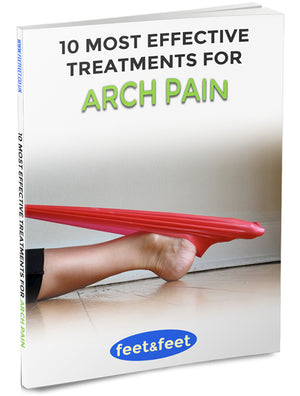Bent Toes? Do You Have Hammer, Claw or Mallet Toes?

Toe deformation is common and in some cases, it's only a cosmetic problem. But when a bent toe – medically referred to as a hammer toe, claw toe or mallet toe – causes severe discomfort and daily problems, it can disrupt your life and wellbeing.
In this article, we'll go over the symptoms, causes and risk factors of these conditions and what treatments are available.
Why Do I Have a Bent Toe?
There are many different causes for bent toes; the most common being prolonged wearing of inadequate shoes. It will place toes in an unnatural position inside the shoes causing them to bend. If this position lasts for a long period of time, it will cause shortening of tendons, joint contracture and the bent toe will become fixed (rigid).
Some people will have bent toes caused by different health conditions. The most common are:
- Diabetes mellitus
- Rheumatoid arthritis or other types of arthritis
- Neuromuscular diseases
- Spinal cord injuries
- Nerve injuries
- High foot arch
If you have a bent toe, it is important to check the cause, get a diagnosis and receive treatment in the early stages.
Common Conditions of a Bent Toe
The most common conditions of a bent toe is a hammer toe, claw toe and mallet toe.
To a non-medical professional they may look the same, but there are differences between these conditions (mainly the location of the affected joint).

Hammer Toe
Hammer toe mainly affects the second toe (though it can affect any toe) and it is characterized by flexion (bending) in the proximal toe joint (middle joint of the toe).
In mild cases, the toe can be extended and the condition can be successfully treated. However, in more severe cases, the toe is rigid and can't be placed back in a natural position without surgery.
In the case that a hammer toe lasts for a longer period of time, it can cause formation of calluses or corns on pressure points. They will usually form at the tip of the toe and on dorsal side of the proximal toe joint (middle joint of the toe).
Claw Toe or Foot
In the case of a claw toe, several foot joints are affected. It usually affects all lesser toes of the foot. The main problem occurs at the metatarosphalangeal joint of the toe (first joint of the toe) located at the base of the toe.
The toe will be placed in hyperextension and point upwards. This will cause adjacent toe joints – located in the middle and at the end of the toe – to bend towards the ground (flexion) so the toe will have claw-like position.
The most common cause of claw toe is joint inflammation and degeneration. But it can also be caused by trauma, neuromuscular diseases which affect foot muscles that become weak.
Mallet Toe
Mallet toe is a deformation which affects distal toe joint located near the tip of the toe. The toe will be bent downwards.
The most common cause of mallet toe is prolonged wearing of small shoes which causes the toe to bend. It usually affects the second toe because in a lot of people it is the longest toe.
Prolonged pressure will cause formation of callosities on the toe tip and on top of the bent toe joint. In more severe cases it can cause ulcers. At the beginning, it is a flexible deformity, but it will become rigid unless it is treated on time.
Symptoms of Bent Toes
The most common symptoms of bent toes include:
- Pain and discomfort
- Corns and calluses
- Inability to move affected toes
- Difficulty walikng
- Aesthetics
- Ulcers
- Inflammation of the toe
In early stages, the toes and feet will hurt while walking and wearing shoes. In later stages, toes can hurt all the time.
At this stage, the toe will be rigid and you won't be able to move it. Corns and calluses will form on pressure spots, most common at the tip of the toe and on top of the affected joint.
Prolonged pressure can cause ulcers and toe inflammation, especially if you have poorly controlled diabetes or other diseases that cause poor blood flow to the toes.
Also, females often have a problem with the way their toes look in open footwear such as high heels and sandals.
Causes of Bent Toes
There are many causes of bent toes, but the most common are:
- Inadequate or small shoes
- Foot arthritis
- Foot joint inflammation (synovitis)
- Neuromuscular diseases
- Diabetes mellitus
- Spinal cord or nerve injuries
- High foot arch
- Foot injuries
- Tight ligaments and tendons
Risk Factors of Bent Toes
The most important risk factors include:
- Age – the risk of developing a condition increases with age
- Sex – the chances of developing a condition are much higher in women than men
- Family history
- Prolonged wearing small and tight shoes
- Length of toes – there's also a higher risk if your second toe is longer than your big toe
- Associated diseases (diabetes, arthritis, neuromuscular diseases, etc.)
Prevention & Treatments
Recommended treatment for bent toes will depend mostly on the stage of deformity. It is important to start with prevention. If you start developing bent toes, start your treatment as soon as possible in order to avoid progression of any disorders and avoid the need for surgery.
Always wear comfortable shoes which doesn't increase pressure on your toes. Make sure that your toes have enough space. If you start developing calluses or corns, you should treat them immediately too. Use daily exercises in order to maintain strength of the foot muscles.
Non-Surgical Treatments
Though there isn't a cure for bent toes since its deformity primarily has a biomechanical cause, there are non-surgical treatments that you may wish to consider.
Non-surgical treatment options include adequate shoes with a proper size and wide toe box, silicone or foam toe sleeves, arch supports, slings and pads.
Surgery
In severe cases of a condition of a bent toe, the toe will become rigid so non-surgical treatment methods will not be very effective for stopping its progression. Surgery will be the only treatment method which will give the patient a chance to get a more functional foot.
The main goal of surgery is to correct the deformity and straighten the toe so it doesn’t lead to problems in everyday life such as wearing shoes.
There are two main types of surgery for bent toes:
- The first one is arthroplasty aimed at allowing more movement in the affected joint
- The other type of surgery is arthrodesis which creates a rigid and straightened toe by removing all of your joint and fusing bones together
If neither of these surgeries is possible, amputation of the affected part of toe is the last option. Toe surgery is not without possible complications which can occur during the procedure or in the postoperative period.




Leave a comment